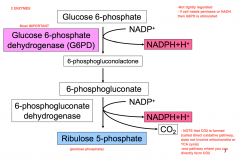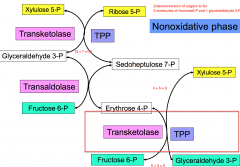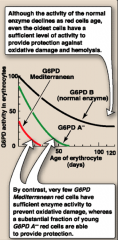![]()
![]()
![]()
Use LEFT and RIGHT arrow keys to navigate between flashcards;
Use UP and DOWN arrow keys to flip the card;
H to show hint;
A reads text to speech;
14 Cards in this Set
- Front
- Back
|
What is the function of the pentose phosphate pathway?
And what are the products used for? |
It is an alternate pathway of glucose metabolism but
It is NOT used to produce energy. Rather it is used to produce: -NADPH - H+ (needed for biosynthetic reactions -Pentoses (Used for nucleotide or nucleic acid synthesis? |
|
|
Where is the pentose phosphate pathway active?
|
Occurs in the cytosol of cells.
It is active is the liver, mammary gland and adipose tissue (NADPH for FA biosynthesis) -Adrenal cortex, testes and ovaries (NADPH for synthesis for steroid hormones) -erythrocytes (NADPH for reduction of glutathione - only pathway that produces NADPH - most susceptible if deficient) -WBC and macrophages (NADPH for phagocytosis) |
|
|
What are the characteristics of the oxidative phase of pentose phosphate pathway?
|

-irreversible reactions
-forms NADPH and pentose phosphate - enzymes are dehydrogenases |
|
|
What are the characteristics of the non- oxidative phase of pentose phosphate pathway?
|

-reversible reactions
-take place where pentoses are not required -enzymes are transketoloase (TPP) and transaldolase |
|
|
What is the affect of low TPP (thiamine) deficiency on transketolase activity?
|
Transketolase uses TPP as a coenzyme. It's activity in RBC can be used as index of nutritional thiamine. Low thiamine results in low activity.
|
|
|
Which cells require only NADPH and pentoses?
|
These will be cells that are involved in protein synthesis. They will only undergo the oxidative phase to produce NADPH and pentoses.
Ribose 5-P is required for nucleotide synthesis, will be formed via isomerization of ribulose 5-P. |
|
|
Which cells require only NADPH and but do not need pentoses?
|
These will be cells that do not require pentose for protein synthesis like RBC.
Pentoses will undergo the non-oxidative phase to produce glycocytic intermediates. |
|
|
Which cells require pentoses only?
|
These will undergo the non-oxidative phase to turn glycolytic intermediates back to pentoses.
|
|
|
What are the used of NADPH?
|
Are used for biosynthetic reactions in fatty acid synthesis and synthesis of steroid hormones.
- Reduction and detoxification of hydrogen peroxide (h202) -Cytochrome P450 system -For phagocytosis in WBCs. -Synthesis of nitric oxide (NO) |
|
|
What is chromic granulomatous disease?
|
It is due to a deficiency of NADPH oxidase needed for WBCs. They are needed for phagocytosis where NADPH generates superoxide free radicals.
Infections results in increased oxidants. |
|
|
How is NADHP used is detoxification of hydrogen peroxide (H2O2)?
|

In RBC, H2O2 is detoxified by glutathione peroxidase to 2 H2O, this will produce a oxidized glutathione. This is converted back to the the reduced formed by GLUTATHIONE REDUCTASE which used NADPH.
Without NAPDH (defect pentose pathway), H2O2 builds up, and damages cell membrane ---> hemolysis in RBC. |
|
|
What is the most common cause of hemolysis in RBC and heinz bodies (what are they)?
|
G6PD deficiency
• Most common enzyme abnormality (X- linked recessive disorder) As a result there is a decrease in the detoxification of free radicals and peroxides formed in cells (H2O2 accumulates and damages cell membrane, resulting in hemolysis) • GSH is also required for maintenance of SH groups in proteins. G6PD deficiency can result in formation of denatured proteins as insoluble masses (Heinz bodies) • G6PD deficiency occurs in all cells, but is most severe in RBCs, as pentose phosphate pathway is the ONLY pathway generating NADPH in RBCs |
|
|
What are perciptating factors?
|
They are factors that cause oxidative stress (results in oxidants)
-infections -oxidant drugs (sulfa drugs, primaquine) -Fava beans Results in low G6PD, which results in low reduced GSH levels. |
|
|
What is GSPD A-?
|

G6PD deficiency
• G6PD Aֿ results in the moderate form of the disease • A significant proportion of young RBCs with G6PD Aֿ have sufficient levels of the enzyme. Patients have hemolytic manifestations when exposed to one of the precipitating factors |

